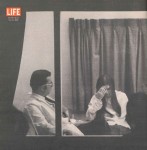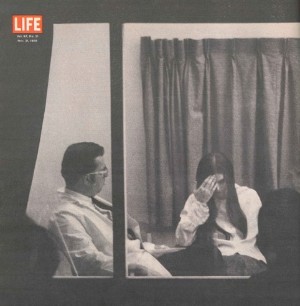
 Carl Nighswonger with a patient, Death and Dying Seminars (1965-69) Billings Hospital, Chicago. From Life, 21 Novembre 1969.
Carl Nighswonger with a patient, Death and Dying Seminars (1965-69) Billings Hospital, Chicago. From Life, 21 Novembre 1969.
The NDE (near-death experience) is a clinical category created in 1975 by the American physician and philosopher Raymond Moody, in his book Life after Life. The author describes the experience of imminent death according to a typology of fifteen stages, including the out-of-body experience, the encounter with deceased relatives, the crossing of a dark tunnel or the fusion with a dazzling light.
Given the enthusiasm, especially American, for the NDE, different hypotheses have been put forward since the 1970s to explain the increase in testimonies. The most common links the high number of near-death stories to the effectiveness of cardiovascular medicine and the resurgence of spirituality on the deathbed. While the improvement of resuscitation techniques has saved lives, increasingly, it is also necessary to note the purely historical willingness of several clinical researchers to collect such stories. Although, it is also a matter of public health in which the psychologization of death and the status of the survivor are central.
In the post-war period, death was at the centre of medical changes. Progress in the treatment of cardiovascular diseases goes hand-in-hand with an increasingly accurate prognosis, which reduces the fatal consequences of serious diseases. In the context of an ageing population, geriatrics is emerging as a new speciality. Biomedical advances have profoundly shifted the hospital and clinical landscape; strengthening the medical power in the background of a redefinition of brain death and a professional ethic based on the extension of patients' lives. While medicine is accused of having made death taboo, a new discussion is emerging around euthanasia, now focused on the rights and dignity of patients.
Since the mid-1960s, many psychotherapeutic techniques have appeared that intercede in patients' fear of death. Psychopharmacological agents such as LSD-25 are used to treat the psychological disorders of patients diagnosed with terminal cancer by simulating the transition from life to death. Other studies are flourishing around the “suicide experience” that highlight the potential decline in fear of death among survivors. Then, a series of important surveys assess people and patients who have survived a serious accident (drowning, a fall, traffic accident). For psychiatrist Russell Noyes and psychologist Roy Kletti, the experience of imminent death — suddenly experienced during an accident — would be qualified according to three stages [1) Resistance 2) Life history 3) Transcendence]. This model analyses the survivor at the intersection of a theory of trauma and mysticism and is comparable to that of Elisabeth Kübler-Ross’ theory. She suggests, similarly, a psychological evolution ranging from denial to the acceptance of death [1) Denial, 2) Anger, 3) Bargaining, 4) Depression, 5) Acceptance].
The various attempts to explain the near-death states raise important questions. Does imminent death imply an apparent state of death, such as prolonged coma, or does it refer to states experienced in full consciousness during a sudden confrontation with death? In the mid-1970s, the notion of imminent death was supplanted by the redefinition of the status of the survivor. In the United States, survivors' experiences are politicized, leading to the inclusion of post-traumatic stress disorder (PTSD) in the DSM-III (Diagnostic and Statistical Manual of Mental Disorders) in 1980. This diagnosis now defines survivors as traumatized rather than ‘enlightened’ beings who would have learned something about the relationship between life and death.
These contradictions show us that the NDE is above all a political object: the narratives serve to illustrate how to treat patients at the end of life, to break the taboo on death, or to thematize spirituality in the time of advanced medicine. What links these disparate researches is the crucial importance they attach to the desire to universalize an extraordinary experience that remains very personal and intimate. The NDE, defined in the middle of the 20th century, finally teaches us more about medico-scientific discourses than about the people concerned and their cultural and spiritual anchoring.
Read more in the dictionary : LSD - Psychedelic - Truth serum
Read the paper in French : Mort imminente (near death experience)
Références :
Martinovic Jelena, Mort imminente. Genèse d’un phénomène scientifique et culturel, Genève, MetisPresses, 2017.
Martinovic Jelena (2019), “A Brief History of Psychiatry and Death”, Harvard Review of Psychiatry, 27;4, pp. 260-267.
To quote this paper : Jelena Martinovic, "Near Death Experience" in Hervé Guillemain (ed.), DicoPolHiS, Le Mans Université, 2021.